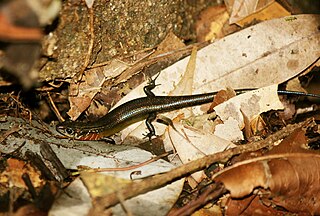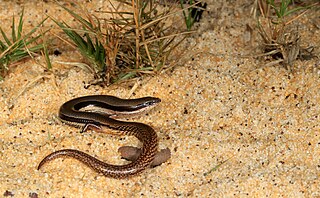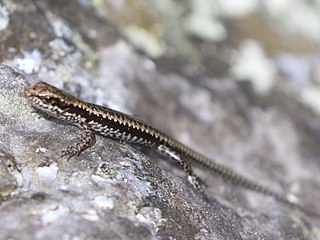
Skinks are lizards belonging to the family Scincidae, a family in the infraorder Scincomorpha. With more than 1,500 described species across 100 different taxonomic genera, the family Scincidae is one of the most diverse families of lizards. Skinks are characterized by their smaller legs in comparison to typical lizards and are found in different habitats except arctic and subarctic regions.

Christinus is a genus of Gekkonidae geckos found in southern regions of Australia. It contains species and subspecies that are regionally termed as marbled geckos. The contrasted patterns of these geckos, marbling, are found in a variety of reddish-brown, grey, silver, white, black and purplish hues. They are frequently found in old knotted trees and sometimes congregate in large numbers in established urban environments.

Anomalopus is a genus of worm-skinks, smallish smooth-scaled burrowing lizards in the family Scincidae. The genus is endemic to the eastern half of Australia. The genus belongs to a clade in the Sphenomorphus group which contains such genera as Ctenotus and the close relatives Eulamprus and Gnypetoscincus.

Eulamprus is a genus of lizards, commonly known as water skinks, in the subfamily Sphenomorphinae of the family Scincidae. The genus is native to Australia.
Geomyersia is a small genus of skinks, lizards in the family Scincidae. The genus is endemic to the Bismarck Archipelago and the Solomon Islands.
Glaphyromorphus is a genus of lizards in the skink family (Scincidae).
Haackgreerius is a genus of skink, a lizard in the family Scincidae. The genus Haackgreerius is endemic to coastal Somalia and contains one species.
Janetaescincus is a genus of burrowing skinks in the family Scincidae. The genus is endemic to the Seychelles. There are two recognized species.

Lankascincus is a genus of lizards, commonly known as lanka skinks and tree skinks, in the family Scincidae. The genus is endemic to Sri Lanka.

Lerista is a diverse genus of skinks endemic to Australia, commonly known as sliders.
Paracontias is a genus of skinks, lizards in the family Scincidae. The genus is endemic to Madagascar.

The genus Sphenomorphus – vernacularly also known as the common skinks – currently serves as a "wastebin taxon" for numerous skinks. While most or all species presently placed here are probably rather close relatives, the genus as presently delimited is likely to be not monophyletic and is in need of review. Some species in this genus have been moved to Pinoyscincus.

Dibamus is a genus of legless lizards in the family Dibamidae.
George Sprague Myers was an American ichthyologist who spent most of his career at Stanford University. He served as the editor of Stanford Ichthyological Bulletin as well as president of the American Society of Ichthyologists and Herpetologists. Myers was also head of the Division of Fishes at the United States National Museum, and held a position as an ichthyologist for the United States Fish and Wildlife Service. He was also an advisor in fisheries and ichthyology to the Brazilian Government.

Concinnia is a genus of skinks in the subfamily Lygosominae.
The cone-eared calyptotis is a species of skink found in Queensland in Australia.
The scute-snouted calyptotis is a species of skink found in New South Wales and Queensland in Australia.
The Thornton Peak calyptotis or Thornton Peak skink is a species of skink found in Queensland in Australia.
Lerista storri, also known commonly as the Mount Surprise slider or Storr's lerista, is a species of lizard in the family Scincidae. The species is endemic to Australia.
Alpinoscincus is a genus of skinks in the subfamily Eugongylinae. The genus Alpinoscincus is endemic to New Guinea.








